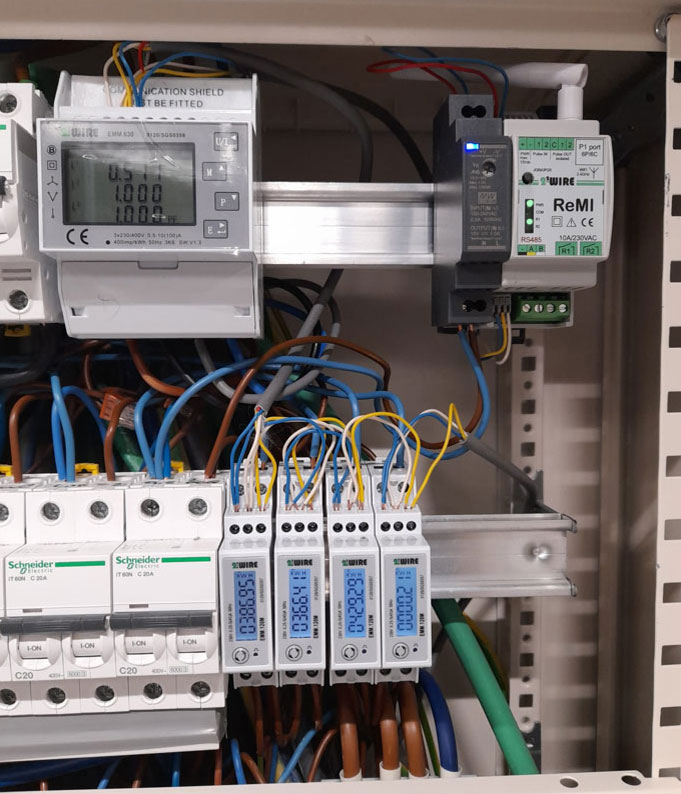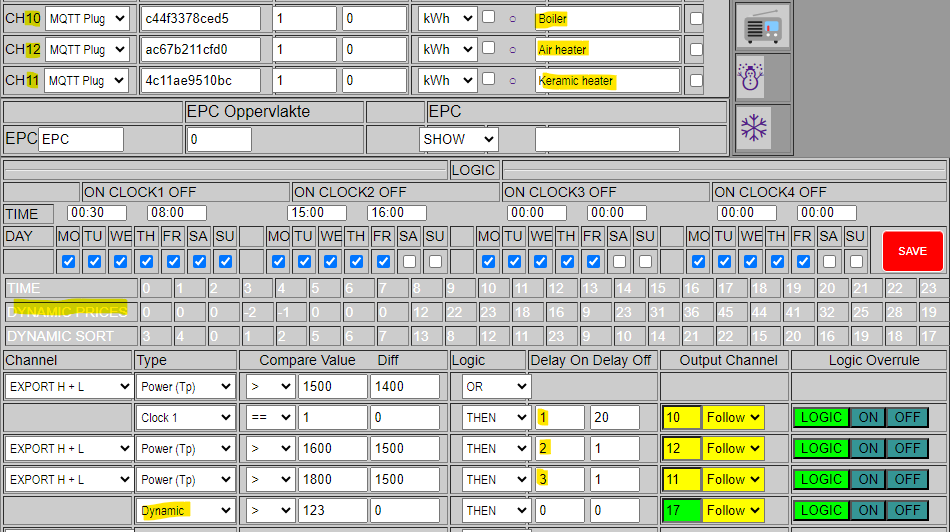With ReMI, discover the ability to accurately monitor both the current and historical energy consumption of your home from any browser-enabled device within your home network. With ReMI, you can measure consumption through the P1 port, connected Modbus meters, IoT smart plugs, meters with pulse output or even through a second ReMI at another location.
What makes ReMI truly unique is the ability to enter and modify simple logic rules. Allows you to smartly switch electric heaters or other large consumers via smart-grid-ready contacts, without interfering with the internal operation of the device being controlled.
By controlling in a smart way, ReMI realizes its own payback period in months, while significantly reducing the payback period for solar panels, all at a pace you determine.
Installer wanted
ReMI is easy to integrate, even into existing installations. However, it is essential that you first try out in your own setup. And thanks to online video tutorials, you’ll become an expert in no time. Thus, make ReMI the ideal gift for all your customers and let them benefit from energy efficiency in the years to come.
As an installer, you can purchase ReMI through the electrical wholesaler
Smart switching also in your home
Every home installation is different but here are a few ideas to increase self-consumption, avoid peaks and consume at low rates, all with one module independent of existing technologies.
Electric water heater: ReMi replaces the former time switch on night rate and turns your water heater into a hot water battery that smartly switches on injection and energy rate. Physical connection to the water heater can be via a 2-wire IOT smartplug or a power contact. Potentially about 1500 kWh annually or nearly 5kWh of energy storage per day.
Home battery. The home battery has internal regulation and will charge itself based on injection, time or dynamic rate. When sometime towards noon the battery is charged, ReMI (with e.g. 5′ delay ON delay) detects injection again and then switches next device to sun.
A standard (basic) charging station: is a large consumer and you can switch it via ReMI (power relay contact, or a 2-wire IoT smartplug, or via a smart-grid contact to the low/boost input on the charging station) manually or smartly on injection, quarter-peak, energy rate,…
The consumption of the charging station can be monitored via a connected Modbus meter type EMM or via a 2-wire IoT smart plug.
An intelligent charging station automatically reads the P1 port and adjusts its internal control based on the set mode, such as, for example, load-balancing mode (boost-mode), solar or dynamic tariff (eco-mode), Time to charge (calender-mode), Priority and price level with multi-users (priority/price-mode), energy sharing with multiple EV stations (share-mode), and so on. The charging mode is determined at the beginning of the charging session, either by the administrator or through the user’s EV app. Having ReMI intervene halfway through by changing the preset mode makes little sense, because no one wants to leave with a dead battery due to conflicting dual control.
If you use ReMI here for another consumer then best via logic switching on a value other than consumption or injection, but for example on the yield of the inverter, or on tariff or time,… The charging station in loadbalance mode will then follow the operation of the home (ReMI).
Heat pump and heat pump boiler: You can connect ReMI one-to-one to any heat pump or heat pump boiler with a smart-grid-ready connection. In this way, you can e.g. use excess solar energy in heating or cooling the home.
Smart heating control entitles you to Fluvius’ SEW premium.
Inverter: Balancing Rule: One can have ReMI turn off the inverter, for example, at a set kWh daily yield to avoid paying for excess energy returned.
Pool pump: In addition to 2 power contacts, ReMI also has 2 solid state outputs. With an additional PEM 01/012 power relay, one can smartly switch the pool circulation pump, for example.
Accumulation: An accumulation heater has its own control module that includes weather-dependent control and temperature protection. ReMi cannot replace this control but can take over the contact for night mode and switch this contact to night rate or injection. Or also avoid spikes by driving 2 separate zone modules in turn.
Electric supplemental heating: An electric heater or IR panel with or without a built-in thermostat are ideal to quickly heat up an occasionally occupied space (bathroom, porch, office,…).
With two lines of logic in the ReMI and a pair of 2-wire IoT plugs, you can smartly switch them according to priority on injection and/or weekly clock, peak,… and thus dramatically increase your own consumption of solar energy.
Energy sharing: With a ReMI at one location, one can measure injection and transmit the values via IoT to a second ReMI, or a 2-wire IoT plug at another location and consume at sun.*
Dynamic tariffs: In Q1 2024 comes the opportunity for ReMI to switch to dynamic energy tariff.* More on this in a future newsletter.
Priority/Operating Time: Delay ON allows you to determine the order “which device switches first,” while Delay OFF allows you to turn a device ON for a minimum time.
*This functionality requires an MQTT license
fig. In the above logic, priority loads the boiler (min.20′) at injection or at night, and only afterwards bid heaters.
Smartgrid ready output(17) is active when energy price < 123 Euro/MWh.
MQTT licenses
Starting in 2024, MQTT Token will change from a one-time purchase to an annual license that must be ordered and activated through the 2-Wire website. For existing tokens, they must be renewed by July 2024.
At the same time, the functionality of our cloud server is further extended to include switching on dynamic rates for the ReMI module, auto backup of the LoWi/ReMI configuration,…
Automatic upgrade
We have recently added automatic firmware upgrade for the LoWi3 and the ReMI module. How to configure auto-upgrade is explained in the online FAQ.
Wishing you a prosperous, healthy and happy 2024 !



